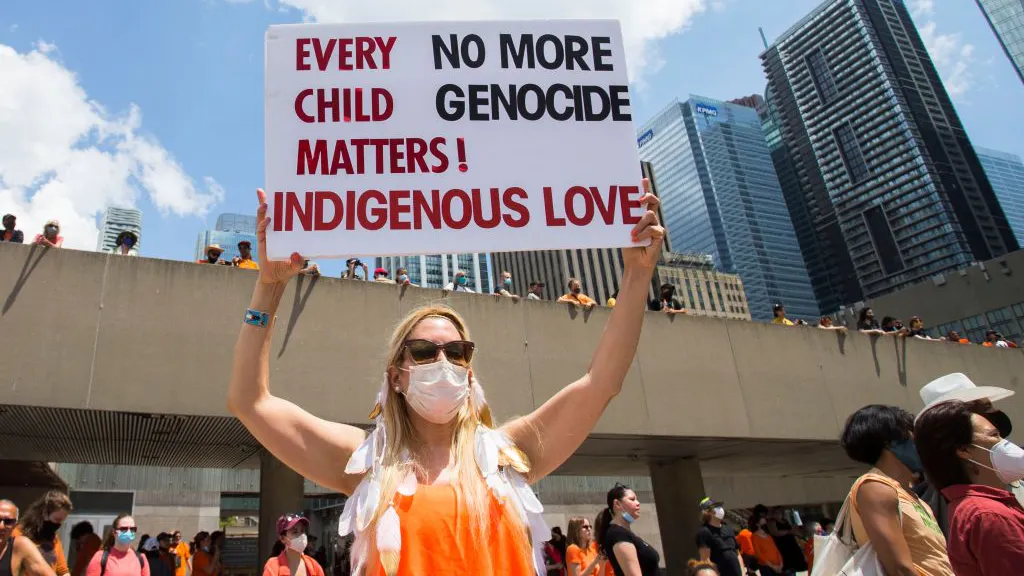A recent excavation project commissioned by a Native American leader at a Catholic church found no evidence of human remains, again casting doubt on allegations of Canada’s so-called “unmarked mass graves.”
Canada was rocked two years ago by reports of hundreds, or even thousands, of these alleged “unmarked mass graves” of Native American children at residential schools, which were funded by the Canadian government and run by Catholics and other Christians. So far, not a single body has been recovered.
Reports from this summer indicated that there could be the remains of 60 children on the premises, and then ground-penetrating radar found 14 “anomalies” in the basement of Our Lady of Seven Sorrows church, which sits beside the former Pine Creek Residential School. Like the dozen other reports before this one, the media suggested these “anomaly” detections were likely the bodies of children who were apparently killed or neglected to the point of death and then secretly buried in these “unmarked graves.” Wanting answers, Chief Derek Nepinak of Pine Creek First Nation helped commission an excavation, which started on July 24 and lasted about four weeks. In August, the chief announced that the team from the University of Brandon found no human remains.
“The archaeological team we hired from the University of Brandon, which is the same archaeological team relied upon by regional police agencies when doing archaeological excavations, found no conclusive evidence of human remains in their excavation of the ground under the church basement,” Chief Nepinak said.
But doubts were cast long before these findings. As noted by Daily Wire reporter Ashe Schow, the narrative about these “mass graves” started to collapse as early as January 2022.
For example, one of the first reports claiming to find these unmarked graves came out of Kamloops, Canada, by an archeologist named Dr. Sarah Beaulieu. Her estimate was at first 215 children, but was later downgraded to 200 “probable burials.” It was later clarified that these “anomalies” just mean disruptions in the soil were found, not necessarily bodies.
Moreover, critiques of Beaulieu suggest the archeologist confused these alleged shallow graves around the school with 2,000 feet of trenches that were dug for the school’s septic system. Beaulieu also cited an alleged “child’s tooth” and rib bone from a juvenile when presenting her findings – but that tooth was found to be non-human and there are no records of the supposed rib bone. Additionally, the Royal Canadian Mounted Police (RCMP) to this day have still not excavated this area in Kamloops.
University of Montreal history professor Jacques Rouillard pushed back on the narrative, saying more excavation work needs to be done. “I don’t like to use the word hoax because it’s too strong but there are also too many falsehoods circulating about this issue with no evidence,” he said, according to the Daily Mail. “This has all been very dark for Canada. We need more excavations so we can know the truth. Too much was said and decided upon before there was any proof.”
CLICK HERE TO GET THE DAILYWIRE+ APP
Daily Wire host Matt Walsh asserted last month that this narrative, which was uncritically pushed strongly by the Canadian and U.S. media, is a hoax meant to demonize Christians. Walsh highlighted the backlash against the Catholic Church in Canada, which included arson and vandalism.
Notably, Pope Francis apologized over the claims, stating, “I humbly beg forgiveness for the evil committed by so many Christians against the Indigenous peoples.” And Canada now has a national holiday over the allegations called the “National Day for Truth and Reconciliation,” celebrated every September 30.
“It is unacceptable and wrong that acts of vandalism and arson are being seen across the country including against Catholic churches,” Trudeau said in 2021. “One of my reflections is that I understand the anger that is out there, against the federal government, against institutions like the Catholic Church, it is real and it is fully understandable given the shameful history we are all becoming more aware of.”
Chief Nepinak fretted over the excavation findings advancing “denialism.”
“We know from our observations of the public at large, that our work will feed into a denialist narrative of what happened to our families in residential schools,” he said. “The results of our excavation under the church are a unique and specific example which should not be compared to other initiatives currently being pursued around other residential school sites across the country.”

.png)
.png)

